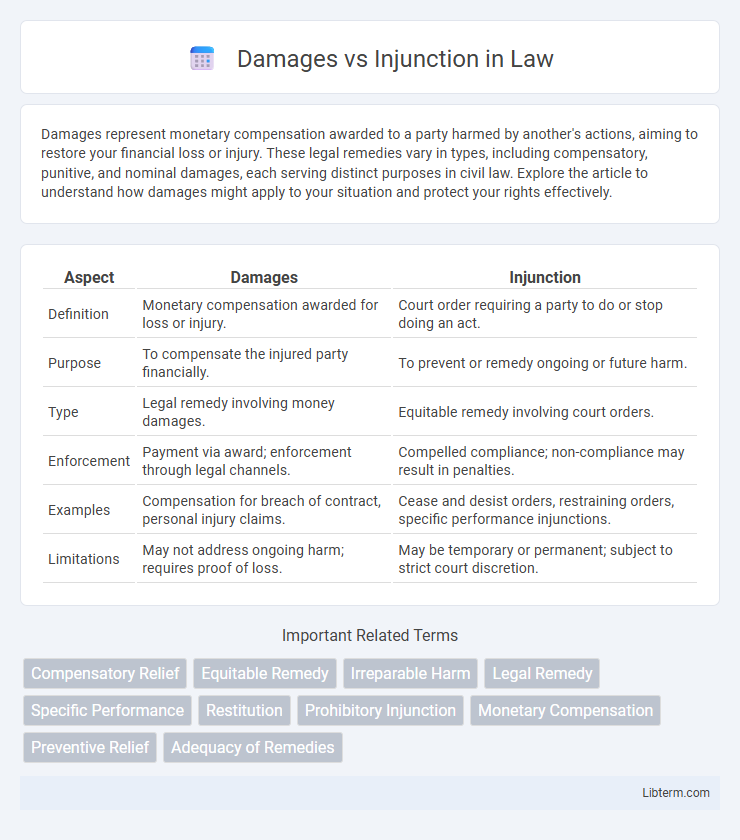Damages represent monetary compensation awarded to a party harmed by another's actions, aiming to restore your financial loss or injury. These legal remedies vary in types, including compensatory, punitive, and nominal damages, each serving distinct purposes in civil law. Explore the article to understand how damages might apply to your situation and protect your rights effectively.
Table of Comparison
| Aspect | Damages | Injunction |
|---|---|---|
| Definition | Monetary compensation awarded for loss or injury. | Court order requiring a party to do or stop doing an act. |
| Purpose | To compensate the injured party financially. | To prevent or remedy ongoing or future harm. |
| Type | Legal remedy involving money damages. | Equitable remedy involving court orders. |
| Enforcement | Payment via award; enforcement through legal channels. | Compelled compliance; non-compliance may result in penalties. |
| Examples | Compensation for breach of contract, personal injury claims. | Cease and desist orders, restraining orders, specific performance injunctions. |
| Limitations | May not address ongoing harm; requires proof of loss. | May be temporary or permanent; subject to strict court discretion. |
Introduction to Damages and Injunctions
Damages refer to monetary compensation awarded to a party injured by another's breach of contract or wrongful act, aimed at restoring the injured party to their original position. Injunctions are court orders requiring a party to either perform a specific act or refrain from particular conduct to prevent ongoing or future harm. Both remedies serve distinct purposes in legal disputes, with damages addressing compensation and injunctions focusing on preventing further injury.
Legal Definitions: Damages vs Injunction
Damages refer to monetary compensation awarded to a party for loss or injury caused by another's breach of contract or wrongful act, aiming to restore the injured party to their original position. An injunction is a court order that requires a party to do or refrain from specific acts, preventing ongoing or future harm rather than providing financial compensation. The legal distinction lies in damages addressing past harm through financial remedy, while injunctions seek to control future conduct to avert irreparable damage.
Types of Damages in Civil Litigation
Types of damages in civil litigation include compensatory, punitive, nominal, and liquidated damages, each serving a distinct legal purpose. Compensatory damages reimburse the plaintiff for actual losses such as medical expenses or property damage, while punitive damages aim to punish the defendant for egregious conduct and deter future wrongdoing. Nominal damages recognize a legal wrong without significant financial loss, and liquidated damages represent a predetermined sum agreed upon in contracts for breach scenarios.
Classification of Injunctions
Injunctions are classified primarily into three types: prohibitory, mandatory, and interlocutory. A prohibitory injunction restrains a party from performing a specific act, a mandatory injunction compels a party to take a particular action, and an interlocutory injunction is granted temporarily until a final decision is made. These classifications guide courts in determining the appropriate remedy to prevent harm or preserve the status quo during litigation.
Key Differences Between Damages and Injunctions
Damages refer to monetary compensation awarded to a plaintiff for loss or injury caused by the defendant's actions, aiming to restore the injured party to their original position. Injunctions are court orders requiring a party to do or refrain from specific actions to prevent harm or maintain status quo, often used in cases where monetary compensation is inadequate. Key differences include damages being retrospective and compensatory, while injunctions are prospective and preventative, reflecting distinct legal remedies in civil litigation.
Criteria for Awarding Damages
Courts award damages based on proven financial loss, causation, and foreseeability of harm resulting from the defendant's actions. The claimant must demonstrate that the breach directly caused quantifiable monetary harm or injury. Unlike injunctions, damages require clear evidence of compensable damage rather than merely preventing future harm.
Conditions for Granting an Injunction
Injunctions are granted when monetary damages are inadequate to remedy the harm, and when there is a likelihood of irreparable injury without court intervention. Courts consider factors such as the balance of equities, the public interest, and the feasibility of enforcement before issuing an injunction. The applicant must demonstrate a substantial likelihood of success on the merits and that the injunction is necessary to prevent significant and irreparable harm.
Advantages and Disadvantages of Each Remedy
Damages provide monetary compensation that quantifies harm, offering clear financial restitution but may be insufficient when the injury involves unique property or ongoing harm, limiting their effectiveness in some cases. Injunctions compel or prohibit specific actions, directly preventing harm and preserving rights, yet they can be difficult to enforce and may impose ongoing court supervision. Choosing between damages and injunctions depends on the nature of the injury, with damages suited for quantifiable losses and injunctions preferable for preventing irreparable harm.
Case Law Examples
In eBay Inc. v. MercExchange, L.L.C. (2006), the U.S. Supreme Court clarified that injunctions in patent disputes are not automatic and must meet a four-factor test including irreparable harm and inadequacy of damages. The case emphasized that damages can be a sufficient remedy where monetary compensation adequately addresses the harm caused by infringement. Another significant example is Apple Inc. v. Samsung Electronics Co. (2016), where the Federal Circuit upheld a permanent injunction but highlighted the ongoing debate between remedies based on damages versus injunctive relief in technology patent cases.
Choosing the Appropriate Remedy
Choosing the appropriate remedy between damages and injunction hinges on the nature and impact of the harm caused. Damages provide monetary compensation for quantifiable losses, suitable when financial restitution can adequately address the injury. Injunctions are preferred when preventing ongoing or future harm is essential, especially in cases involving breaches of contract, intellectual property violations, or environmental harms that cannot be remedied by money alone.
Damages Infographic

 libterm.com
libterm.com